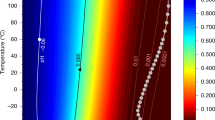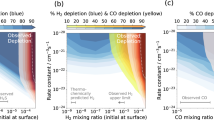Abstract
WHILE the surface conditions of Venus make the hypothesis of life there implausible, the clouds of Venus are a different story altogether. As was pointed out some years ago1, water, carbon dioxide and sunlight—the prerequisites for photosynthesis—are plentiful in the vicinity of the clouds. Since then, good additional evidence has been provided that the clouds are composed of ice crystals at their tops2,3, and it seems likely that there are water droplets toward their bottoms4. Independent evidence for water vapour also exists5. The temperature at the cloud tops is about 210° K, and at the cloud bottoms is probably at least 260–280° K (refs. 4 and 6). Atmospheric pressure at this temperature level is about 1 atm.7. The observed planetary albedo falls steeply in the violet and ultra-violet8, which accounts for the pale lemon yellow colour of Venus. The albedo decline would not be expected for pure ice particles, and must therefore be caused by some contaminant. Dust, ozone, C3O2 and other gases may possibly explain these data but, whatever the explanation, the ultra-violet flux below the clouds is likely to be low. If small amounts of minerals are stirred up to the clouds from the surface, it is by no means difficult to imagine an indigenous biology in the clouds of Venus. What follows is one such speculation.
Similar content being viewed by others
References
Sagan, C., Science, 133, 849 (1961).
Bottema, M., Plummer, W., Strong, J., and Zander, R., J. Geophys. Res., 70, 4401 (1965).
Sagan, C., and Pollack, J. B., J. Geophys. Res., 72, 469 (1967).
Pollack, J. B., and Sagan, C., Astrophys. J. (in the press; Sept. 1967 issue).
Dollfus, A., C.R. Acad. Sci., 256, 3250 (1963); Bottema, M., Plummer, W., and Strong, J., Ann. d' Astrophys., 28, 225 (1964); Belton, M. J. S., and Hunten, D. M., Astrophys. J., 146, 307 (1966); Spinrad, H., and Shawl, S. J., ibid., 146, 328 (1966).
Pollack, J. B., and Sagan, C., J. Geophys. Res., 70, 4403 (1965).
Chamberlain, J. W., Astrophys. J., 136, 582 (1965).
Harris, D. L., in Planets and Satellites (edit. by Kuiper, G. P., and Middle-hurst, B. M.), 272 (University of Chicago Press, 1961).
Compare, Sagan, C., and Leonard, J. N., in Planets, 190 (Life Science Library, Time-Life Books, NY, 1966); Shklovskii, I. S., and Sagan, C., in Intelligent Life in the Universe, 329 (Holden-Day, San Francisco, 1966). The organisms postulated here are designed for the cloud levels of Jovian planets.
Gest, H., and Kamen, M. D., Handbuch der Pflanzenphysiologie (edit. by Ruhland, U.), 5, chap. 4 (Springer-Verlag, Berlin, 1958); Gest, H., in Proc. Intern. Symp. Enzyme Chem., 250 (Academic Press, NY, 1958).
Author information
Authors and Affiliations
Rights and permissions
About this article
Cite this article
MOROWITZ, H., SAGAN, C. Life in the Clouds of Venus?. Nature 215, 1259–1260 (1967). https://doi.org/10.1038/2151259a0
Received:
Issue Date:
DOI: https://doi.org/10.1038/2151259a0
- Springer Nature Limited
This article is cited by
-
The Habitability of Venus
Space Science Reviews (2023)
-
Proposed energy-metabolisms cannot explain the atmospheric chemistry of Venus
Nature Communications (2022)
-
Water activity in Venus’s uninhabitable clouds and other planetary atmospheres
Nature Astronomy (2021)
-
Phosphine gas in the cloud decks of Venus
Nature Astronomy (2020)
-
RETRACTED ARTICLE: Life on Venus and the interplanetary transfer of biota from Earth
Astrophysics and Space Science (2019)





